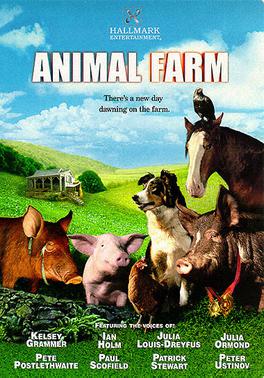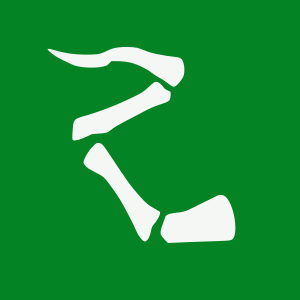Animal Farm (1999 film) facts for kids
Quick facts for kids Animal Farm |
|
|---|---|

Theatrical poster
|
|
| Based on | Animal Farm by George Orwell |
| Written by | Alan Janes Martyn Burke (teleplay) |
| Directed by | John Stephenson |
| Starring | Kelsey Grammer Ian Holm Julia Louis-Dreyfus Patrick Stewart Julia Ormond Paul Scofield Pete Postlethwaite Peter Ustinov |
| Theme music composer | Richard Harvey |
| Country of origin | United States United Kingdom |
| Original language(s) | English |
| Production | |
| Producer(s) | Greg Smith Robert Halmi |
| Cinematography | Mike Brewster |
| Editor(s) | Colin Green |
| Running time | 91 minutes |
| Distributor | Hallmark Films |
| Budget | $23 million |
| Release | |
| Original network | TNT |
| Original release | 3 October 1999 |
Animal Farm is a 1999 British-American TV movie. It was directed by John Stephenson and written by Alan Janes. The film is based on the famous 1945 book Animal Farm by George Orwell.
The story is about a group of animals who can talk and think like humans. They successfully rebel against their human farmer, Mr. Jones. But after their revolution, the animals slowly fall under a new, harsh rule by some of their own kind. The film uses animals to show how power can be misused and how revolutions can sometimes lead to new forms of unfairness.
Contents
Meet the Characters
The film features a mix of real actors and voice actors for the animals.
Human Characters
- Pete Postlethwaite as Mr. Jones: He is the first owner of Manor Farm. The animals overthrow him because he treats them badly. In the story, he represents Czar Nicholas II, a ruler from Russia's past.
- Caroline Gray as Mrs. Jones: Mr. Jones's wife.
- Alan Stanford as Pilkington: He owns a nearby farm called Foxwood Farm. He later works with Napoleon. He represents the British ruling class.
- Gail Fitzpatrick as Mrs. Pilkington: Pilkington's wife.
- Gerard Walsh as Frederick: He owns Pinchfield Farm. He represents Adolf Hitler, a famous dictator.
Animal Voices
- Julia Ormond as Jessie: A smart and good Border collie dog. She tells the story of the film. She represents the ordinary people who suffer under a dictator.
- Patrick Stewart as Napoleon: A greedy pig who becomes the harsh ruler of Animal Farm. He represents Joseph Stalin, a powerful leader of the Soviet Union.
- Ian Holm as Squealer: A clever Tamworth pig who is Napoleon's helper. He spreads Napoleon's messages and lies, acting like a minister of propaganda. He represents Vyacheslav Molotov, a Soviet politician.
- Julia Louis-Dreyfus as Mollie: A young horse who loves ribbons and fancy things. She represents people who left Russia after the revolution because they liked their old, comfortable lives.
- Kelsey Grammer as Snowball: A noble pig who leads Animal Farm after Old Major dies and Mr. Jones is gone. Napoleon later forces him to leave. He represents Leon Trotsky, another Soviet leader who was forced out.
- Pete Postlethwaite as Benjamin: A wise donkey and Boxer's close friend. He is the oldest animal on the farm. He represents smart people who saw what was happening but didn't act. Postlethwaite also played Mr. Jones.
- Paul Scofield as Boxer: A kind and strong shire horse. He works very hard for the farm but is later sent away to be made into glue. He represents hard-working people who are used and then discarded.
- Peter Ustinov as Old Major: A wise and kind pig who inspires the animals to rebel. He represents Karl Marx and Vladimir Lenin, who were important thinkers behind communism.
- Charles Dale as Moses: A funny raven who used to be Mr. Jones's pet. He later works with Napoleon. He represents organized religion.
- Dale also plays Pincher, a Rottweiler who becomes Napoleon's bodyguard.
- Jean Beith as Muriel: An old Saanen goat.
Book vs. Film: What's Different?
The 1999 film of Animal Farm has some differences from George Orwell's original book.
- In the movie, Jessie the dog is the main character and tells the story. The book doesn't have one main animal character.
- The film has only four main pigs (Old Major, Snowball, Napoleon, and Squealer). In the book, there are more pigs who take charge.
- Old Major dies differently. In the book, he dies of old age. In the movie, he is accidentally shot.
- The animal rebellion happens at night in the movie, but during the day in the book.
- In the movie, Boxer the horse breaks open the feed shed door. In the book, a cow does it.
- The humans try to get the farm back only once in the movie. In the book, they try twice.
- In the movie, the puppies who become Napoleon's guards are Jessie's children. In the book, they are the offspring of Jessie and another dog, Bluebell.
- Mr. Pilkington has a bigger role in trading with the animals in the film, making shady deals. In the book, Mr. Frederick is the one who tricks them with fake money.
- Mollie the horse leaves the farm later in the movie (after Boxer's death) than in the book (soon after the revolution).
- The pigs use a TV and film for propaganda in the movie, which doesn't happen in the book.
- The windmill is destroyed only once by Mr. Jones in the movie. In the book, it's destroyed twice, once by a storm and once by humans.
- The story in the movie takes place over a few days. In the book, it covers many years.
- Boxer's injury is different. In the book, he gets shot in the leg. In the movie, his leg is not shot, but he still collapses from overworking. In both, the pigs send him to a factory, lying that he's going to a hospital.
- In the book, new pigs are born after Napoleon takes over. This doesn't happen in the movie.
- Moses the raven is not religious in the movie, unlike in the book where he talks about "Sugar Candy Mountain."
- At the end of the movie, Jessie realizes the pigs and humans look alike by seeing them through a dirty window. In the book, all the animals see it when they spy on a meeting.
- In the movie, only Napoleon walks upright and wears clothes. In the book, all the pigs start walking on two legs and wearing clothes.
- Some animals, including Jessie, escape into the woods in the movie and return later when Napoleon's rule fails. In the book, there is no happy ending, and the animals don't escape.
- The movie ends with a new, kind family moving into the farm, suggesting a better future. This hopeful ending is not in the book.
See also
 In Spanish: Rebelión en la granja (película de 1999) para niños
In Spanish: Rebelión en la granja (película de 1999) para niños



